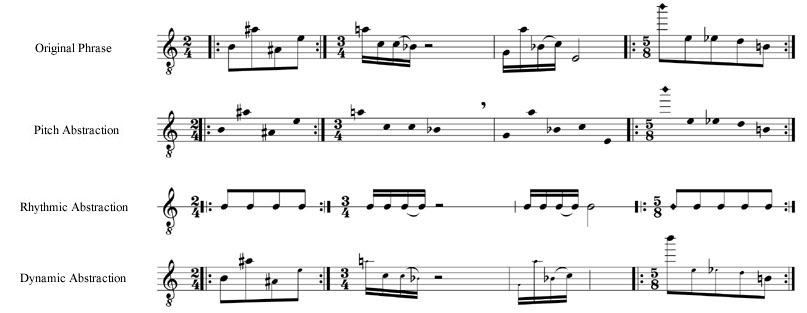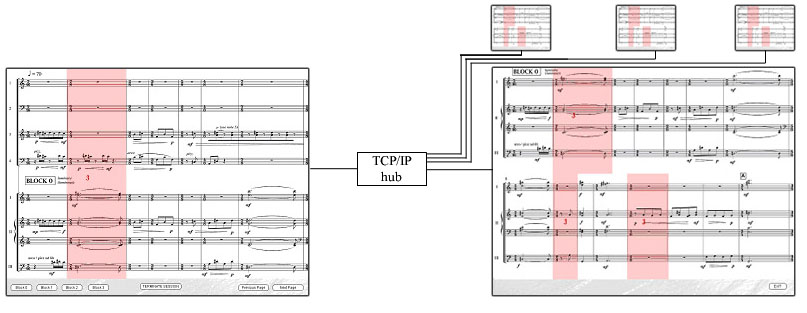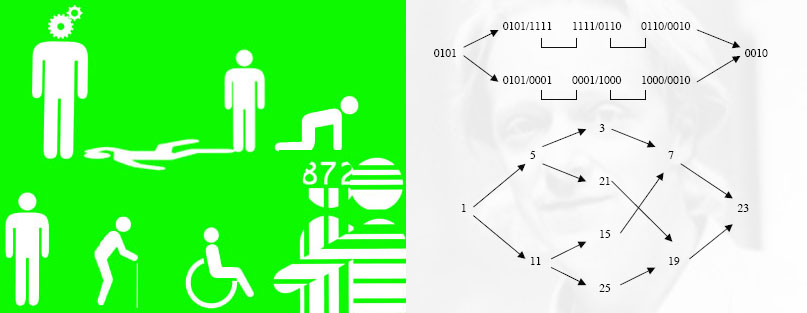
Example parametric abstractions of a phrase from Continuum with Blues.
Please note: some links on this page are in maintenance.
Active Notation is the collective name for a set of approaches that seek to ‘re-conceptualise’ the nature of notation and the performers relationship with it: that musical notation no longer needs to be fixed upon the page, but can, with computer technology, be dynamically delivered to the performer in new ways. Central to this is the use of the laptop to replace the conventional music stand. This use of the computer
as an integral element of composition makes these works for Active Notation successors to Nigel Morgan’s previous compositions with interactive systems, such as ARRAY: Compass and Interactions. The following pages provide an outline of Nigel Morgan’s pieces for Active Notation.
Continuum with Blues (for electric guitar) was the first experiment in using Active Notation to create a piece in which the entire final movement was not ‘fixed’, but could be re-ordered either by the player or computer. Furthermore, phrases in the piece may be shown with one or more parametric elements abstracted (for example, a melodic phrase may be shown with an absence of rhythmic information).
Continuum with Blues was premiered by Alan Thomas in a collaboration between Manchester Metropolitan University and Plymouth University during the ICCMR seminar series in 2007. The event, which has been archived here, had Nigel Morgan’s paper Re-Conceptualising Performance with ‘Active’ Notation presented in Plymouth with ‘live’ illustrations from a concert taking place on the MMU campus.
 Active Notation system for Self Portrait. The screen of the musical director’s laptop (left) shows a full view of the piece, while players (right) have tailored versions for their instrumental groups.
Active Notation system for Self Portrait. The screen of the musical director’s laptop (left) shows a full view of the piece, while players (right) have tailored versions for their instrumental groups.Fifteen Images (Le Jardin Pluvieux) (2009) goes beyond the use of Active Notation as a method of simply re-ordering and suggesting possible interpretations of the fully notated score. It incorporates these elements and additionally allows the performer to investigate the compositional process itself as part of a unique multilayer online score.In such a multi-layered approach the performer-improviser can decide which
representation, or representations, of the material might be displayed during performance. He or she may be happiest playing from a harmonic abstract overlaid with some rhythmic detail. Alternatively, once acquainted with the scales or colour-tonalities that each Image is based around, performance may be read from an abstracted version of the score showing no common notation at all: simply the play of colour.

Images from Pippo Lionni’s Facts of Life and John Dack’s Notes on the Realisation of Scambi.
Scambi. This Active Notation reinterpretation will allow the performer to assemble a performance in the same way that a performance of the original tape work is realised, using dynamic recording and playback to simulate the multiple speaker configurations that would be integral to a performance of Pousseur’s tape version.
